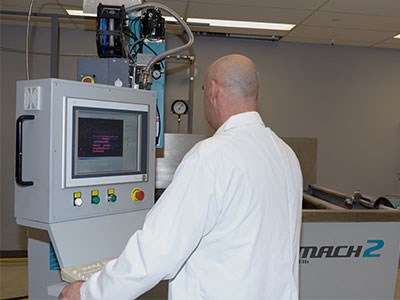The innocent, untrained eye is immediately drawn to ICAMPs foremost attraction: towering industrial robots with cutting edge computerized control.
But that same excitement is felt by industry leaders who get to witness ICAMP’s impressive lineup of industrial robotics and computerized numerical control (CNC) capabilities.
Equipped with a quiver of the highest quality robotics and CNC technology, ICAMP provides precise programming specific to each and every project; what you program is what you get.
The automation of these machine tools allows companies to break away from the traditional manual control method and exponentially improve their own capabilities.
Now, computers and robots play the integral role.
“Very few companies in Northern Ontario have invested in robotic technology so far, and I think the big reason for that is that, until very recently, it just wasn’t cost-effective; if you’re spending all this money on a robot, but you only have to make a small amount for a customer, the cost justification just isn’t there,” Butler-Jones explained.
ICAMP, specifically, boasts three different multi-axis manufacturing robots with exceptional function flexibility and offer the companies’ exposure and exploration of these capabilities to see what they can do for their business.
Most notably, they house an enormous IRB 4600 industrial robot, known industry-wide as the standard-setting tool for its sharp path accuracy and motion control.
With the longest vertical reach in its class and the versatility of being mounted on a track system, the robot has significantly shortened cycle times and increased productivity.
Add that to the 9-axis CNC milling machine, the ultimate tool for saving processing times on complex parts thanks to its simultaneous task completion.
Those tools, alone, have significantly created value in their ability to redefine product capabilities to their end user at even more competitive prices.
Northern Ontario industries, like the mining sector in particular, will undoubtedly continue to come calling for ICAMP’s robotic technology as skilled labour challenges loom on the horizon.
“When you look at the forecast for the use of robotics in industry, it just continues growing very quickly and I think that’s because the robots are getting more capable,” said Butler-Jones.
“Soon, they will be reaching industries where it didn’t make cost-sense before,” ICAMP’s applied research leader added. “For northern Ontario companies that haven’t thought about robotics before, it’s getting pretty close to the point where they need to be thinking about them.”
With capabilities and increased affordability of modern robotics, there are no more excuses for falling along the wayside or becoming obsolete thanks to their pure productivity potential.
Even if the idea of a complex network of high-functioning robots sounds a little too complicated, ICAMP has included a FlexTrainer portable robotic cell specifically designed for robotic training purposes.
Ideal for arc welding, material handling and vision guidance, the six-axis training robot cell provides programming and operational instruction and an overview of the main system components.
“Whereas it used to be more difficult to find the right technical employee, get the right training and be able to afford the piece of equipment needed to reach the next stage, we can make those connections at ICAMP,” said Butler-Jones. “They can come in and see our robots, learn how they work and get familiar with the technology.”
Mixed in with that arsenal are water jet cutting tools and other machining devices capable of cutting a wide variety of materials; there are literally no limits on what kind of material ICAMP can cut and manufacture.
Materials up to 6 inches thick can be sliced through with the extreme precision and execution, which has been exploited by many an industry collaborator for cutting and shaping, predominantly from the mining and aerospace sectors.
“If we didn’t have those capabilities, we would be missing a major factor in manufacturing,” Butler-Jones said bluntly.
Along with the rest of the state-of-the-art technology at ICAMP, all of the equipment was acquired with immense input from industry; if they needed it, ICAMP went out and got it.
“As the robots become more capable and become a good fit for those industries, we want to make sure that we can help companies make use of that,” said Butler-Jones. “We want to make sure that we are ahead of the curve of robotics as they become more capable and make more sense for smaller companies to use.”
That mentality continues to drive the innovation centre, as they continue to evolve and stay up to date and upgrade in order to cater to their collaborators.




